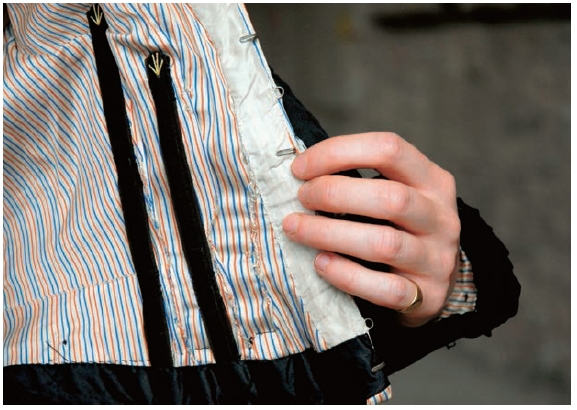Chapter 9: Services and sharing
The starting point for a good deal of innovation around sustainability is to try to dissociate business success from relentless expansion of material consumption, in an attempt to temper resource depletion, pollution generation and associated effects such as climate change. This of course seems a particularly Herculean task for the fashion sector, whose structure is shaped so profoundly by the expansionist model of economic growth where increasing sales of new items is the most important route to increasing profits and expanding market share.
For some years now, business concepts focused on services rather than products have been put forward as offering optimal potential for sustainability improvements. Their secret is to use the pursuit of efficiency to drive resource use down and profits up. Service-oriented businesses can be formulated in many different ways, from repair and hire services to ‘open source’ design services, where garment patterns are freely shared and open for users to make at home. The challenge here is to design the business model as much as to design the garments that are traded in it; and for the requirements of each to shape the other.
Repair services
A key element of many sustainability-focused business models is the possibility of earning income by working in ways other than just selling more material units. Repair services contribute to this goal by helping people return their garments back to good condition and charging for that service. Alteration and mending services are, of course, nothing new and have been an established part of many laundering and tailoring enterprises for many years. However, in formally acknowledging the contribution and relevance of repair work to the overall sustainability profile of the fashion sector, repair is shifted from a stand-alone, ad hoc set of activities to an element that is intrinsic to the overall effectiveness of the fashion ‘system’. Impromptu organizations are already becoming established with or without official fashion industry sanction. Social Fabric Collaborative in San Francisco, for example, provides workshops where professional designers help non-professionals repair and make garments for themselves, starting with simply sewing on a button. Classes are run in collaboration with the Bike Kitchen, a DIY bicycle repair training organization. By associating with an already accepted product maintenance community, Social Fabric asks us to question why we do not also treat our clothing the way we treat our bicycles.
Historical precedents are rich with insight into the possibility of repair, alteration and maintenance of clothes. Textiles – and the clothes they are made into – only became plentiful in the twentieth century. Before that, they were highly valued items that were carefully maintained because of both their cost and their scarcity. Many of the techniques that were used to keep clothes wearable for the longest possible time combined details to prevent damage with after-the-fact repair, including: patching or edging worn sections; adding tape or braid to hems, cuffs and necklines to prevent fraying; and building large seams or hems into garments so they could be easily altered. For most people, there are few economic savings brought by repairing garments today, mainly due to the low price of new garments relative to the high price of labour for repair. Yet the increasing scarcity and cost of natural resources such as oil and fresh water may act to shift the balance back in favour of repair, and a changing economic and natural climate may usher in a different set of social and material norms.
The limitations of and possibilities for repair rarely, if ever, influence the design of a new garment.

Braided hems and patched and repaired lining in a jacket from the Victorian era.
Design for repair
Repair has traditionally been seen as an activity separate from and consecutive to design and production; those specialists altering or repairing clothes tend to do so regardless of the garment’s design, not because of it. Yet opportunities do exist for building future repair and resilience into articles of clothing. Certain sorts of garments naturally seem most suited to this approach – expensive ‘classic’ pieces, for example – yet when these innovative approaches are fused with emotional durability, design for disassembly and adaptability, their application has potential to reach far beyond this niche to many more markets and people.
From his mobile ‘ice-cream cart’ equipped with an old treadle sewing machine, Michael Swaine mends people’s clothes for free on street corners in San Francisco. He hems trousers, patches jackets and sews on buttons – originally as part of an art project on generosity, but nine years later, more because of the relationships and trust he has built up with local people. Swaine claims his cart – and the act of repair – has created a community space for talking and has reconnected garments once again to the ‘thread of life’.

Michael Swaine repairing clothes from his cart on the streets of San Francisco.
Leasing systems
Changing the ways in which products are organized, distributed and used offers the prospect of reducing the amount of materials we consume while still meeting people’s needs. One of the key ways in which we can do this is to move from the traditional model of ‘owning’ garments to one based on ‘leasing’. When a garment is leased, a consumer buys its utility or the results it offers (its fashionability, warmth, protection and so on), rather than the material object itself. Perhaps one of the most common examples of garment leasing is formalwear; the morning tailcoat hired, say, for a wedding. Here the wearer requires the elegance and sense of tradition signified by the coat, and not the permanent ownership of it. This small but not insignificant shift away from exclusive ownership to shared access has the potential to reduce the number of garments that are produced. Clothes hire, library or leasing systems thus work to break the predominant ‘one garment to one wearer’ relationship that typifies most of our experience of using clothes. The challenge is to increase the number of wearers so that the resources that make up each garment are used as intensively as possible.
Informally, many of us may have already acted in ways that change the one-to-one garment-to-wearer ratio by, for example, buying and then trading back vintage garments (a kind of covert long-term leasing) or by sharing clothes with close friends, with the main limitation being that for a garment to be easily shared, the people doing the sharing have to be a similar size to ensure the garment fits properly. UK-based knitwear company Keep and Share uses this constraint as a point of innovation, designing loose shapes with minimal fit points at particular places where body dimensions vary the least. The result is a design concept built with pieces that make sharing both more likely and more practical.
The logic of leasing
The logic behind leasing systems borrows heavily from a set of ideas perfected in consumer economies, and particularly from the notion of efficiency. In leasing, a producer maintains ownership over a garment, rather than selling it. And because garments represent an investment, the producer continually searches for ways in which to make a profit on that investment by increasing the efficiency with which the garments are used. The incentive is to work the garments harder; to make more money, which in the case of a clothing service, is to own few, durable garments and to hire them out to as many individuals as possible for as long as possible.
Online accessories company Avelle (formally Bag, Borrow or Steal) offers a rental service for high-end handbags, jewellery and sunglasses. Once a member of the leasing service (around US$5 monthly fee), a customer can rent an item for a week, a month or as long as they want, with rates varying from $15 per week for everyday bags to $150 per week for vintage. All products have been used before and customers are encouraged to take care of the pieces: ‘Think of what you borrow as being on loan from a good friend.’ Avelle actively promotes its service as a high-status, consumer ‘nirvana’, ‘for handbag addicts it is the ultimate fantasy: an endless stream of pristine designer bags delivered straight to one’s doorstep’.20 Yet behind this consumer-friendly front, there is a business model in place that makes money from leasing each bag as many times as possible. To encourage this to happen, Avelle uses, for example, a queuing system on its web site so that consumers can see how long they will have to wait to hire a particular piece.
Design services
Another variation on the leasing systems theme is the development of service opportunities around the design of garments. Instead of setting up services to repair or alter existing garments, or to hire garments or other textile products to users, design services themselves can be sold. By tracking back up the supply chain and isolating key functions and potential markets, a service can be developed that has the promise of sustainability benefits.

Bag from online accessories rental company Avelle.

Short jacket by SANS, for which a downloadable pattern is available online.
The influence of the Internet
The Internet offers new opportunities for direct contact between a pattern-cutter and a home-sewer, allowing for bespoke designs to be produced. Design services can thus work with new technology and the flows of fashion expression while at the same time nudging dominant models of clothing production in new directions. Garments can for example be designed, cut and sewn independent of commercial fashion opportunity or wholly inside it: self-assembly inspired by an image from the fashion press and facilitated by a commercially available garment kit. Other features of Web-based activity, such as open-source co-operative design initiatives, also offer opportunities for sustainability-inspired design services in fashion. Publishing designs and garment patterns under ‘copyleft’ licensing – that is, to be duplicated freely, adapted and shared again rather than protected with ‘copyright’ as is the norm – begins to subvert the hierarchical, power and commercial dynamics of fashion. The outcomes are fashion pieces with a design concept of an entire (global) community, made with the prowess of an individual, most likely from the materials they have to hand, with additional options inevitably opening up through the use of whole-garment knitting machines and the increased availability of rapid prototyping.

Trench coat reworked in Junky Styling’s wardrobe surgery.
In addition to its ready-to-wear lines, US fashion brand SANS offers downloadable patterns over the Internet. The patterns are designed to be home-printer-friendly and sections of the pattern, printed on a series of A4 sheets of paper, first have to be assembled before a garment can be cut. Its Home Made initiative started with three basic T-shirt designs, but has now grown to include pieces from the current collection, so blurring the boundaries between fashion labels as producers of finished garments and as fashion service providers and finding new ways for people to relate to their clothes. As the Home Made collection strapline states: ‘Pattern made in New York. Garment made wherever you are.’
Other models of design services
Junky Styling has been creating new garments from waste ones – most notably from men’s suits – for well over a decade. But more recently it has set up a ‘wardrobe surgery’ at the back of its London store to overhaul, customize or simply alter old, ill-fitting or worn-out clothes. Customers are invited to be part of the design process, to discuss garment preferences and recurring problems encountered with the cut and fit of the piece as was. The garment is then redesigned and reworked and the customer invited in for fitting adjustments: thus the core business of the brand is expanded and raises revenue from remodelling existing garments.
